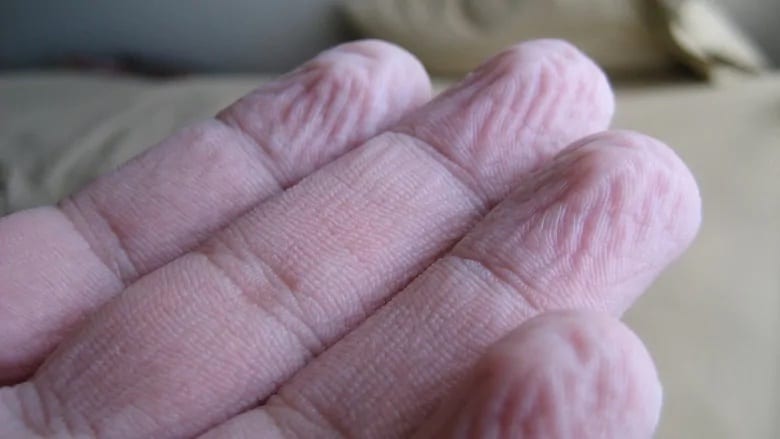Knowledge is power, especially when you are talking about pain science. However, we all know that all information on the web isn’t created equally.
In fact, a lot is created by people that have no medical knowledge. Or robots.
One group of patients we help at Adelaide West Physio is those with persisting pain.
We feel strongly in our bones that understanding pain science is a key component of overcoming persistent pain.
I decided that creating a regular series on Facebook and Instagram called ‘Tuesday Nuggets’ would give a forum to talking about persistent pain amongst other things. Little bite-sized chunks of info that might help out.
This blog is a collection of these pain science knowledge nuggets.
[Forward this page to a friend with persistent pain. It just might help them out!]

Pain is always real
NO ONE can tell you that your pain isn’t real. How could they possible know?
The pain you experience is yours and yours only. It can’t be shared. It is only designed to protect one person – you.
Imagine telling someone with phantom limb pain that their pain isn’t real. They’d punch you in the nose!
The closest that someone can get to knowing how much pain you have is your description, or your grimace, or your grunt when you get up.
They might see the way you move differently. But that isn’t pain, it is ‘pain behaviour’.
Sometimes it would be easier if the therapist could ‘download the pain’ and see it on a monitor – but that can’t be done.
The idea of rating it on a scale of 0 to 10 is flakey too, because it’s not like your 5/10 can be compared to another person’s 5/10.
The main value of that kind of rating is that it helps your therapist to tell if your pain is changing at all.
No one has the right to make assumptions about your pain. Pain is always real. And it can’t be compared.

You don't even need a body part to have pain in it!
This might seem a bit weird at first, but it says a lot about how pain works!
Phantom limb pain and other phantom limb sensations are common in amputees.
It is pretty hard to rationalise having pain in a body part that is no longer there, UNLESS you consider that a ‘map’ of the body part still exists in the brain and in the rest of the body.
This might make it a little easier for the person with longstanding pain to understand how you can have pain in a body part that isn’t damaged any longer, that may have actually healed.
Anyone with persistent pain should stop and have a think about this example. Ruminate a little!
If you are thinking that your pain is a measure of your tissue damage, phantom limb pain doesn’t make any sense at all.
But what we know about pain science helps:
- your central nervous system (including your brain) is always involved in pain
- you have a map of your body part held in your brain
- pain is about protection, rather than being about measuring your tissue damage
Then phantom limb pain can make sense, and it might help to explain pain that continues, even after the area has healed.

There are no pain detectors in your back!
Actually, there are no pain detectors ANYWHERE in the body. Or pain nerves. Or pain areas in your brain.
There are danger, pressure, stretch, chemical, heat and cold detectors. Light detectors. Vibration detectors. But NOT pain detectors.
That’s because pain is an experience that you … well … experience.
Like love. You don’t have love detectors. Or anger detectors. Or hunger detectors.
You have chemical, stretch receptors, pressure receptors …
You get the experience of love, anger or hunger after all of the inputs have been fully evaluated.
Just like in pain.

Pain is your brain's opinion that you need protection
Here’s a tasty nugget! If you have problems with pain, chew on this and let it digest…
Your brain is making decisions all day and all night. It doesn’t stop. And it’s not nearly as simple as taking the incoming information on face value.
Your brain is judging everything against its predictions and expectations that you aren’t even aware of!
It is continually coming up with ‘opinions’.
The processing is even quicker than Google coming up with search results for you when you type in a query, and takes into account of many more data points
Keep in mind that our brain’s number one job is to keep the show going, and to keep you safe and out of trouble.
It makes sense then that there are times when it might err a little on the conservative side of things, particularly if something similar has happened before.
So if you brain is of the opinion that you need protection, it can produce pain.
But as you know, opinions aren’t always right, and sometimes your brain gets it WRONG.
If you don’t believe me that your brain can get it wrong, ANY visual illusion will prove that your brain can easily get it wrong!!
In persistent pain, it often gets it wrong, and maintains a level of protection that is no longer required.

Your sensitivity changes moment to moment

Hurt does not always equal harm
- We grow up associating pain with injury
- We tend to associate the how bad the pain is with the how bad the injury is.
However, you can have pain without tissue injury. Just put your hand under hot water tap that is just a bit too hot.
It can hurt a lot, but without causing injury.
And that’s how it is with persistent pain, osteoarthritis, low back pain and lots of other scenarios.
You can do something that hurts, but it usually doesn’t mean you have done harm.
You have just alerted your ‘protection by pain’ system.

It only takes 5% weight loss to reduce pain
![]() This is something nice to chew on!
This is something nice to chew on!
![]() It is amazing to think that reducing body weight by 5% is associated with a meaningful improvement in pain and disability in people who are overweight and have osteoarthritis.
It is amazing to think that reducing body weight by 5% is associated with a meaningful improvement in pain and disability in people who are overweight and have osteoarthritis.
![]() This statement gets thrown around a bit as a little factoid. It appears to be from a study on knee osteoarthritis so it can’t be extrapolated automatically to hip osteoarthritis or anything else (Christensen et al 2017 https://doi.org/10.3945/ajcn.117.158543)
This statement gets thrown around a bit as a little factoid. It appears to be from a study on knee osteoarthritis so it can’t be extrapolated automatically to hip osteoarthritis or anything else (Christensen et al 2017 https://doi.org/10.3945/ajcn.117.158543)
![]() However, there is strong support for healthier eating reducing body-wide inflammation and therefore reducing body-wide pain.
However, there is strong support for healthier eating reducing body-wide inflammation and therefore reducing body-wide pain.

Cartilage can repair
While cartilage doesn’t have the repair speed of other tissues (not having a blood supply certainly counts against it!) it still has the ability to repair.
If your cartilage did have blood vessels, they would get squashed. Instead, your cartilage takes advantage of this squashing – your cartilage gets the nutrients squeezed into it from the joint fluid. This is why moving is so good!
Chondrocytes are the cells that produce the components of cartilage. They need to have a reason to work and repair.
If there is no reason (like if the joint isn’t being used enough) there won’t be enough stimulus to help the repair process happen. In fact, the opposite will happen – the health of the cartilage will suffer.
You can under dose or over dose the stimulus too.
How do you avoid this? A plan and an understanding of how to safely progress is the key.
The GLA:D program is a great way to get the knowledge you need and get your the exercise routine started.

Pain requires a brain but it is the person that hurts
🧠 This is important to remember!
🧠 When you read about the modern understanding of pain, there is an emphasis on the brain. Sometimes we say ‘the brain produces pain’. But is it really that simple?
🧠 There is no doubt that the brain is an important part of the process (you can’t have pain without a brain). But so is you spinal cord, your immune system, your endocrine system etc
🧠 Pain is a personal experience where the brain is an integral part of the process.

Things you say to yourself can be potent messages (so are they correct?)

Acute inflammation has a purpose. So why try to suppress it?
It is your basic immune response. It has an important purpose:
🤜 It starts off the cleanup operation
🤜 It helps damaged tissue to heal
🤜 It protects you by making things sensitive while injured tissue is more vulnerable
So why would you want to prevent it doing its job? 🤷🏻♂️
NB: low level systemic inflammation and chronic inflammation are a different story!
Click here to learn about how we incorporate this pain science information into our back pain physio management.

XRay, CT, MRI, Ultrasound.
They can tell you how things 'look' but they CAN NOT tell you about pain.
‘A picture is worth 1000 words’, they say.
However, all a picture can do is tell you about how things look. The landscape of your insides.
There is a poor correlation between imaging findings and pain.
That’s because pain is A LOT more complicated (and interesting) than just being about the physical structure of our body.
They don’t take into account all the components that are involved in pain.

The balance between DIMs and SIMs powers the Protectometer.
Pain is all about DIM SIMs.
DIM = evidence of ‘Danger In Me’
SIM = evidence of ‘Safety In Me’
We are constantly weighing up all the contributors to each of these categories, all day, every day, without knowing it. Even in your sleep.
If the evidence of danger outweighs the evidence of safety, your Protectometer produces pain!

Can you turn your DIMs into SIMs?
Can you take things that are scary, threatening or overwhelming about your situation or your problem, and take away the threat? 🫣
Can you defuse a DIM (danger in me)? 🤔
Or better still, can you take a DIM and turn it into a SIM (safety in me)? 😁
This usually takes the help of a modern and enlightened health practitioner to guide the way and to show how it can be done.
It usually takes updating your knowledge about your problem, which requires the right people with the right knowledge – but they are out there!
If you can defuse a DIM or turn a DIM into a SIM, it is a critical step in the journey to reducing persistent pain. 👌
Doing this is turning down the ‘Protectometer’.

Use your SIMs to outweigh your DIMs
On a set of scales, the aim is to have balance on either side. If you add more weight or take weight away, it tips the scales.
Now think of pain like a set of scales.
On one side are things that are likely to ‘contribute’ to pain, on the other side are things that are likely to ‘uncontribute’ to pain.
To help persistent pain you want to tip the scales!
The aim is to maximise the things on the ‘uncontribute’ side and have less things on the ‘contribute’ side.
That is, more SIMs (safety in me) than DIMs (danger in me).
You can help tip the scales in your favour by adding more SIMs to your life. They could be anything that promotes good / safe / protection / health / happiness.






And that’s just the start.
Keep working on tipping the scales in your favour!

How can you 'reassure' your protective systems that you are actually ... OK?
There are many ways to ‘reassure’ your protective systems that you are OK if they have become OVERprotective.
1. Explore your SIMs (your ‘safety in me’ signals and activites).
2. Reduce the effect of your DIMSs (your ‘danger in me’ signals and activities)
3. Get the right information about your problem – a diagnosis that makes sense to you, that you can explain to someone else if you needed to, that is backed by science (not pseudosciencey explanations)
4. Don’t read the wrong information – make sure you are getting it from a trusted source and don’t Google it!!
5. Have a plan (sounds simple, but it’s so true)
6. Deal with health professionals that listen and understand.
7. Move, exercise, meditate, be with positive people.
Remember – you might be someone with pain but YOU ARE NOT YOUR PAIN!!

Neurons that fire together wire together
🤔 If you practice something, the connections become more efficient at that ‘thing’.
If you practice a skill, it gets easier. This is the basis of neuroplasticity.
A pathway that starts as a dirt road becomes a superhighway.
There are many positives to this neuroplasticity, but it can produce problems.
🤔 If you practice thinking something, you think it more automatically.
So you’d better make sure that what you are thinking is fully accurate and not some horribly inaccurate assessment of what is happening in your body or with your pain!
Persistent pain becomes persistent by your brain ‘practicing’ pain. It becomes better at it, and produces it more easily.
🤔 It is this neuroplasticity that can get you into trouble with persistent pain. BUT it’s also what can get you out of trouble too!

You've heard of phantom pain. Have you heard of phantom stiffness?
😮 Phantom pain is a weird phenomenon.
It is pain in a body part that isn’t physically there, either because it has been amputated or it wasn’t there from birth.
So why should you care?
Because it shows that pain cannot be a perfect representation of the state of your body tissues.
😮 Phantom stiffness works the same way as phantom pain.
Stiffness is an experience. It is created by your body, particularly involving the brain and spinal cord. It doesn’t have to involve a body part.
As long as the ‘map’ of the body part exists in the brain, that absent body part can experience pain, stiffness, tingling. Even orgasm.

Edgy and turned on. All our systems can become overprotective with repeated use.
We have protection systems that (usually) work well straight out the box 💯
Like the immune system, the hormone system, the muscle system and of course the pain system.
They work fabulously well until they are made to work often or too much.
The pain system works really well in acute situations. It can save your life!
😳 However if it stays ‘switched on’ and goes from good healthy protection to overprotection, it becomes a real problem.
Don’t think that it is just about the pain system though – all of these systems can get edgy if they are worked too much or too hard.

Bioplasticity. It's what got you into this situation, and it can get you out of it too.
Bioplasticity is about how we change and adapt. All the way through life. In all our systems. Right until our last breath
Bioplasticity is the thing that makes any comparison between humans and cars completely null and void.
(Like ‘you need alignment regularly like a car needs a wheel alignment or the tires wear out more quickly’)
Can a car adapt or heal itself? No. Not even Teslas.
Bioplasticity is also the feature that is involved in persistent pain. In this case, the adaptation isn’t a helpful one. Becoming more sensitive to normal stimuli isn’t useful.
But the good news is that bioplasticity is also the thing that can get your OUT of trouble, with the right strategies, but it needs to be combined with:
• patience
• persistence
• courage and
• commitment
Together, they are the winning formula for persistent pain

No one knows how much you hurt.

Celebrate the wins. Especially the small ones.
It’s pretty easy to brush them off, especially if you continue to have pain.
Instead, it really helps if you can celebrate your wins. Even if you have to look for them!
It doesn’t have to be an overt display of balloons and glitter cannons. Acknowledging them silently will do!
For one thing, it gives you a bit of energy to keep going. If you would like a flood of happy hormones like dopamine and serotonin, just think about something you have achieved that you feel good about.
These help you to remember this step, this moment and gives you a chance to build on it.
Reflection is good to practice for all of us, but particularly people who are on their journey with persistent pain.

Reduce Your systemic inflammation for pain relief (and much more)

More Activity + more knowledge + less systemic inflammation = a solid plan

Having goals is important when dealing with pain but this is only half true.

Pain is never detected - IT IS ONLY PRODUCED.

You have your own internal drug cabinet - YOU HAVE FULL ACCESS TO IT.

Your gut produces 80-90% of your serotonin!

There are more than 500 areas in the brain involved in pain

The brain is like an orchestra

Learning about pain helps pain
There is good evidence that learning how pain works biologically can help your pain.
It can be a relief to find out that there is a reason that things can still hurt, and that it’s not ‘all in your head’
Once you understand why it still hurts, then you can start taking the necessary steps.
Otherwise, there is no incentive to exercise or move if all it does is hurt when you do.
You can learn about pain biology in many ways – there are great books you can read, there are lots of great free videos (just search Lorimer Moseley, Tame The Beast or NOIgroup for starters.
There are great apps like Protectometer and Curable.
Of course, you can speak with one of us!
We love helping people suffering persistent pain, and helping them take the right path to getting the best our of life.

Pain isn't your only protective measure (but it's the most noticeable)
Our body has many different protective measures – pain is only one of those but you can’t miss it!
You can detect a danger like fire in different ways using different senses (vision, smell, hearing, touch).
You have systems like your sympathetic nervous system to get you out of danger, your respiratory system kicks in, you might swear a bit, you might switch on different muscle groups HARD to get you moving and away from danger.
It’s just that pain is the protective system that gets our attention the most because it is unpleasant – but that is the whole point of it.

Pain can be modified by anything - you won't necessarily be aware of it!
- People you are with.
- The place you are.
- What you believe about the pain.
- The words you use to describe the pain.
- Distractions.
- Survival.
- Smells, tastes, sounds.

You can't rest persistent pain better

When things continue to hurt, it isn't because something is unhealed

The longer you have pain, the easier it gets produced

It isn't 'all in your head' but the brain is boss.
Other articles that might be of interest
Nociception and Tissue Injury – One of the biggest errors that you hear from all kinds of clever people is conflating the idea of nociception, tissue damage and pain. They are NOT the same thing!
Low Back Pain – The ‘Pathoanatomical’ Approach – Traditionally, low back pain has been looked on in a ‘biomedical’ or ‘pathoanatomical’ way. What does this mean? And why doesn’t work with persistent back pain?
Words Affect Pain – My aim in this article is to demonstrate that not only can poorly chosen terms reduce people’s expectations, words can directly affect pain.


















